
Iceland in Winter - The Ultimate Travel Guide

- What to Do in Winter in Iceland
- What To Know About Winter in Iceland
- Keep Your Plans Flexible
- Daylight Will Be Limited
- The Highlands Are Inaccessible
- Winter Weather in Iceland
- Average temperature in November
- Average temperature in December
- Average temperature in January and February
- Average temperature in March
- Safety in Winter
- The Icelandic Wind Warning System
- What to Pack for Winter in Iceland
- Photographing Iceland in Winter
- Driving in Iceland in Winter
- Renting a Car for a Winter Trip
- Driving Safely in the Icelandic Winter
- Winter in Different Parts of Iceland
- Winter in the South of Iceland
- Winter in the North of Iceland
- Winter in the West of Iceland
- Winter in the Westfjords of Iceland
- Winter in the East of Iceland
- Icelandic Wildlife in Winter
- Winter Holidays And Events in Iceland
- Spending Christmas in Iceland
- The Icelandic New Years
- Bolludagur, Sprengidagur and Oskudagur
- Valentine's Day, Bondadagur and Konudagur
- Thorri and traditional food
- FAQs About Iceland in Winter
- Are all attractions accessible in winter in Iceland?
- What's the best way to travel around Iceland in winter?
- Is it safe to go glacier hiking or ice caving during winter in Iceland?
- Can I camp during winter in Iceland?
- What can I do in Reykjavik in winter?
- Summary of Iceland in Winter
Iceland is known for its dramatic landscapes, and during winter, they take on an ethereal quality. It's an ideal time to enjoy the northern lights, go ice caving, or embark on a snowy adventure. Experience everything that the country has to offer during the low season.
Winter in Iceland starts in November and lasts until early April, and depending on which month you visit, you'll have a very different experience. During the height of winter, Iceland is draped with a blanket of snow which creates a dramatic contrast with the beautiful landscape, and the waterfalls transform into pillars of ice.
The highlight of Iceland's winter season is the elusive northern lights or aurora borealis. This celestial phenomenon fills the night sky with a mesmerizing array of colors dancing over nature, and Iceland offers some of the best opportunities to witness this magical display. You can choose from a selection of northern lights hotels to maximize your chances of viewing them.
Winter activities cater to a wide range of interests, from adventure-seekers to nature enthusiasts. Exploring ice caves, glacier hiking, and snowmobiling are just a few of the thrilling experiences that await. The country's iconic attractions, such as the Golden Circle, the Skogafoss waterfall, and Diamond Beach, also take on a unique charm when enveloped with ice and snow.
Overall, Iceland in winter gives visitors a chance to see a different side of the country's nature with more unique activities. Read on to find out everything you need to know about visiting Iceland in winter.
What to Do in Winter in Iceland
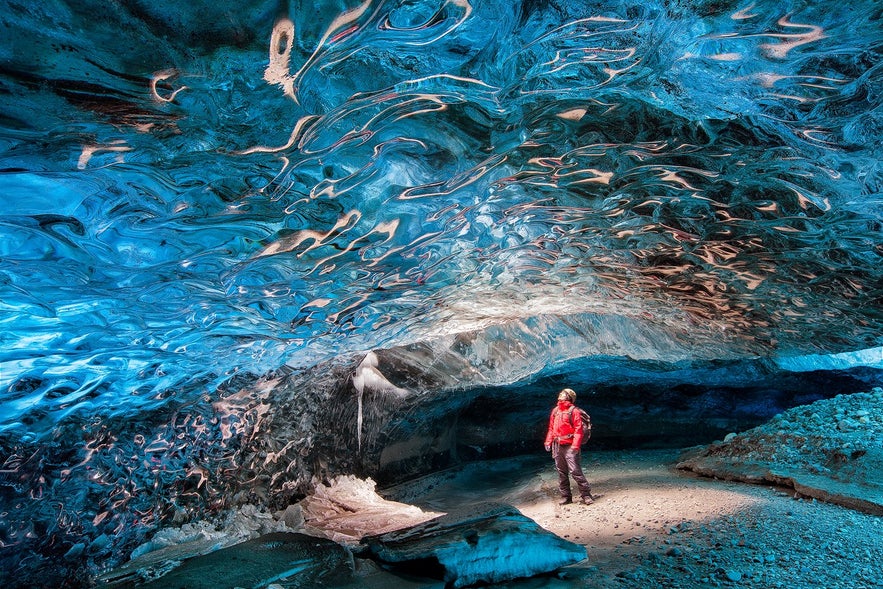 The Icelandic winter offers an array of activities and attractions that cater to a wide range of interests. Of the winter months, November until the middle of December is the best time to do a self-drive tour with a rental car, as the weather isn't as challenging as in later months. The height of winter is from January until March, so the best things to do are winter sports and activities, taking nature tours, and exploring Reykjavik and surrounding towns. There is no shortage of things to do! Just make sure to keep your schedule flexible to account for weather changes as needed.
The Icelandic winter offers an array of activities and attractions that cater to a wide range of interests. Of the winter months, November until the middle of December is the best time to do a self-drive tour with a rental car, as the weather isn't as challenging as in later months. The height of winter is from January until March, so the best things to do are winter sports and activities, taking nature tours, and exploring Reykjavik and surrounding towns. There is no shortage of things to do! Just make sure to keep your schedule flexible to account for weather changes as needed.
-
See the northern lights: The dark winter months are by far the best time to witness the northern lights. Clear, cloudless skies are ideal for optimal viewing. To increase your chances of spotting them, head away from urban areas and venture into the remote countryside, where there's minimal light pollution. Make sure to check out the weather conditions and the aurora forecast before you head out hunting for them.
-
Go glacier hiking or ice caving: Explore the glaciers of Iceland with a glacier hiking tour, or visit an ice cave guided by experts to ensure safety. With the ever-changing nature of glaciers, each winter brings new ice cave experiences, and you'll be able to visit the best ice caves with this ice-caving tour on the Vatnajokull glacier.
-
Visit the Golden Circle: One of the most popular tourist routes in Iceland is the Golden Circle, which encompasses three iconic attractions: Thingvellir National Park, Geysir geothermal area, and Gullfoss waterfall. While most commonly explored in summer, these locations are just as beautiful in the frozen winter! You can check it out on a self-drive tour or on a guided Golden Circle tour.
-
Explore nature on exciting tours: Winter offers many thrilling opportunities for enjoying Icelandic nature. Traverse the countryside with a snowmobile tour or go dog sledding with Siberian Huskies! You can also go on horseriding tours on Icelandic horses in their fluffy winter coat!
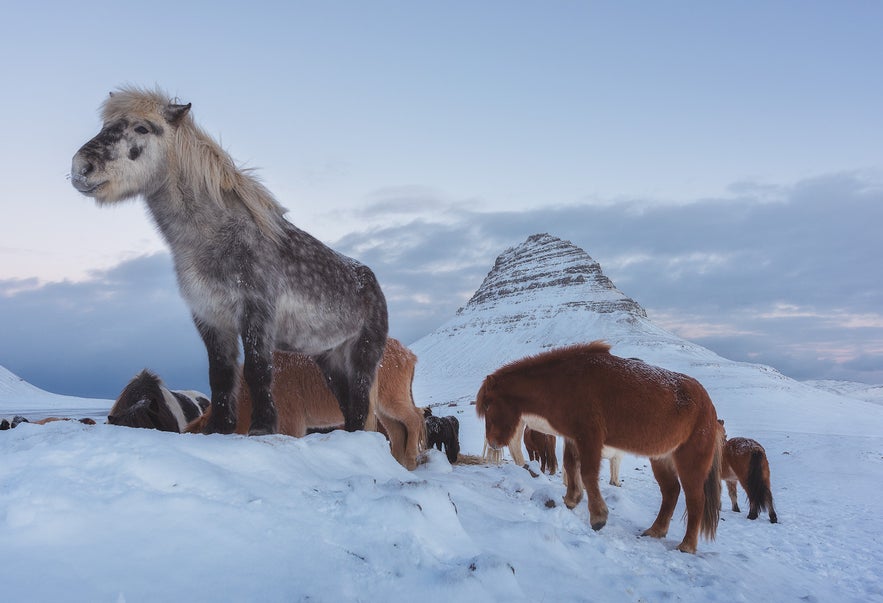
-
Go whale-watching: While summer is the most popular time to go whale-watching in Iceland, going during winter can be just as enjoyable. Just make sure to wrap up warm and take good gloves.
-
Relax in geothermal spas, lagoons, and pools: It may sound contradictory, but the winter weather creates a great atmosphere for relaxing in Iceland's many geothermally heated lagoons and pools. There are few things as refreshing as feeling the cold air on your face while you soak in the hot water. Locations like the famous Blue Lagoon, Sky Lagoon, or the Hvammsvik Hot Springs will all be far less crowded this time of year as well.
Overall, there are many things to do during winter in Iceland. It's a great time to experience some unique activities, whether you're interested in nature, adventure, or getting to know the culture.
What To Know About Winter in Iceland
Keep Your Plans Flexible
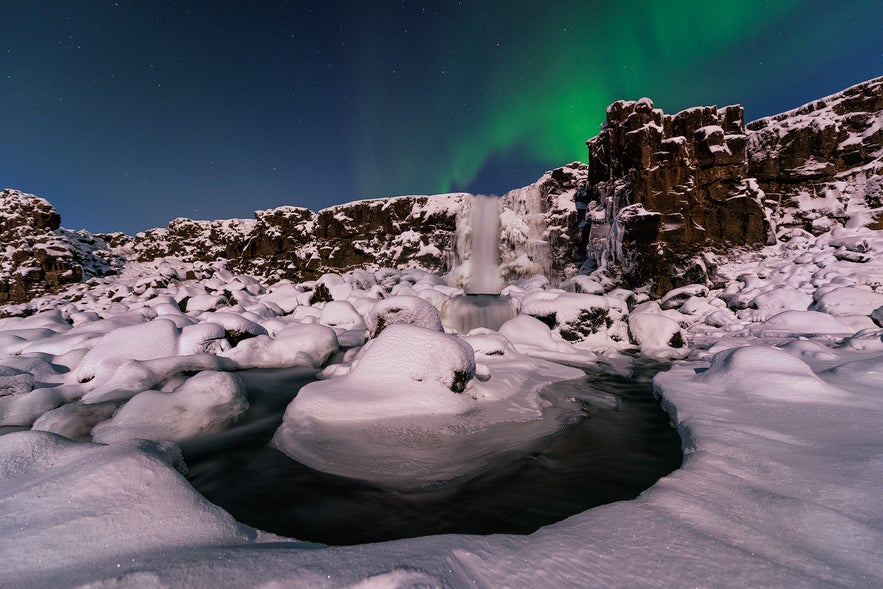
When visiting Iceland in winter, it's essential to keep your plans flexible due to the unpredictable nature of the weather. Iceland's winter months are known for rapidly changing conditions, which can include high winds, icy roads, and snowstorms. These elements can impact travel plans, making it vital for visitors to remain adaptable and open to adjustments in their itineraries.
One way to ensure flexibility is by allowing extra time for travel between destinations. Weather-related delays are common, and by accounting for additional travel time, you can reduce stress and avoid potential safety risks. It's also helpful to have alternative activities or attractions in mind in case your initial plans are disrupted by weather conditions.
Monitoring local weather forecasts and road conditions is crucial during your visit. Websites like the Icelandic Meteorological Office and the Icelandic Road and Coastal Administration provide valuable, up-to-date information on weather and road conditions throughout the country. It's also a good idea to keep an eye on the SafeTravel website for information about traveling safely in Iceland. There, you can also sign up for safety notifications and download their app. Make sure to use these available resources and be prepared to adjust your plans accordingly.
Daylight Will Be Limited

During winter in Iceland, daylight hours are limited due to the country's high latitude and proximity to the Arctic Circle. As winter approaches, daylight gradually decreases until the winter solstice. It occurs around December 21st and marks the shortest day of the year, with approximately four hours of daylight in Reykjavik and even less in the northern parts of the country. As the season progresses, daylight hours gradually increase, with approximately ten hours of daylight by the end of March.
The limited daylight can be both a challenge and an opportunity for travelers visiting Iceland during winter. On one hand, the short days require planning to make the most of the available daylight for outdoor activities and sightseeing. Many attractions and guided tours operate within the daylight hours, making efficient use of this time.
On the other hand, the extended darkness creates ideal conditions for viewing the northern lights, as the likelihood of spotting the celestial phenomenon increases with longer, darker nights. Moreover, the twilight hours of winter in Iceland provide a unique, soft light that casts a serene ambiance over the landscapes, creating an opportunity for great photographs!
The Highlands Are Inaccessible
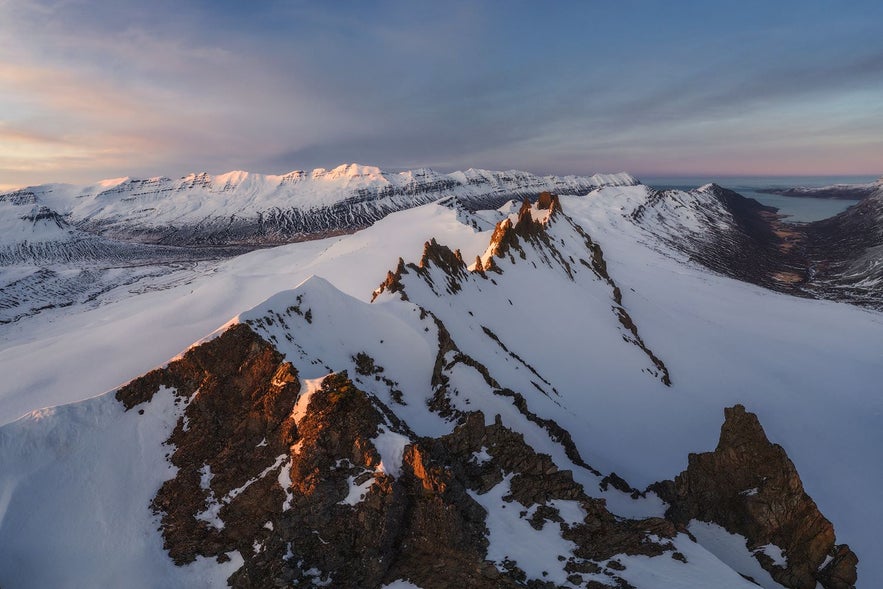
During the winter months in Iceland, the highland roads, also known as F-roads, are closed due to heavy snowfall, ice, and harsh weather conditions. These closures are necessary to ensure the safety of travelers and to preserve the delicate highland environment. The highlands, which are home to some of Iceland's most remote and stunning landscapes, become inaccessible during this time.
Road closures usually begin in September or early October and can last until late May or June, depending on weather conditions and road maintenance efforts. The exact dates of closures vary from year to year, depending on the severity of the winter season.
Other roads can close temporarily as well because of harsh weather conditions or snowfall, sometimes with short notice. It's, therefore, crucial to monitor road conditions and closures as you travel around the country.
Winter Weather in Iceland
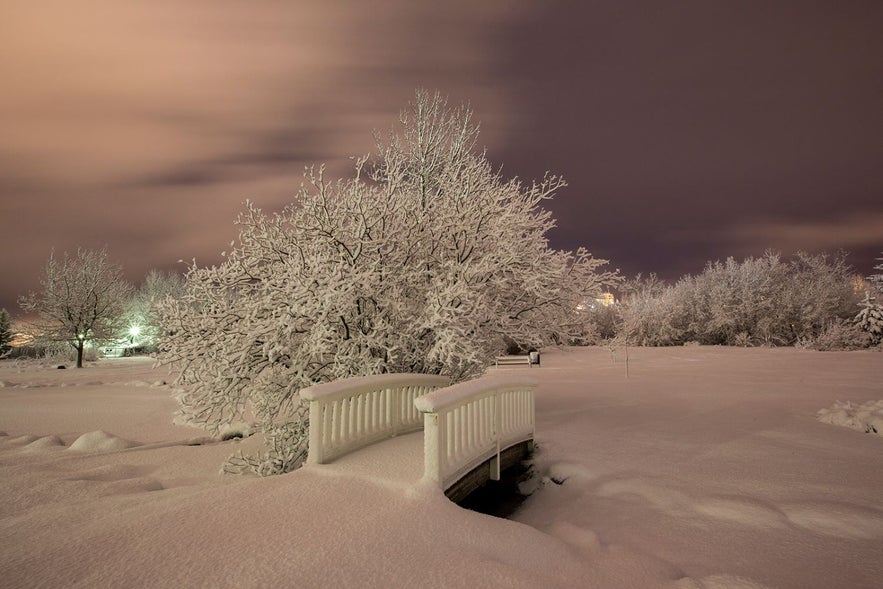 Winter in Iceland spans from November to March and is characterized by its cold and unpredictable weather. Coastal regions tend to be slightly milder due to the moderating influence of the Gulf Stream, while inland and mountainous areas experience colder conditions.
Winter in Iceland spans from November to March and is characterized by its cold and unpredictable weather. Coastal regions tend to be slightly milder due to the moderating influence of the Gulf Stream, while inland and mountainous areas experience colder conditions.
Iceland's winter weather can change rapidly, with bright sunshine one moment and snowstorms the next. Snowfall is common, especially in the northern regions and the highlands, while the south coast experiences more rain and sleet. High winds and icy conditions can also occur, making travel more challenging.
Average temperature in November
In November, Iceland is transitioning into winter, with the weather becoming increasingly cold. Average temperatures range from 30°F (-1°C) to 39°F (4°C). There's a risk of ice on the roads and light snow at the end of the month.
Average temperature in December
December in Iceland brings frigid temperatures, ranging from 23°F (-5°C) to 36°F (2°C), and limited daylight hours, peaking at the winter solstice with only 4 hours of sunlight. Icy roads and high winds are common, and there may be snowfall.
Average temperature in January and February
January and February are Iceland's coldest months, with average temperatures ranging from 14°F (-10°C) to 37°F (3°C). If the winter is particularly harsh, the temperature can go down to 5°F (-15°C) for some days, though this is not common. Snowfall is generally frequent, and high winds and icy roads pose challenges for travel.
Average temperature in March
March in Iceland marks the transition from winter to spring, with temperatures ranging from 28°F (-2°C) to 37°F (3°C). Snowfall becomes less frequent, but icy conditions and high winds may persist. Daylight hours increase to around 11-12 hours by month's end.
Safety in Winter
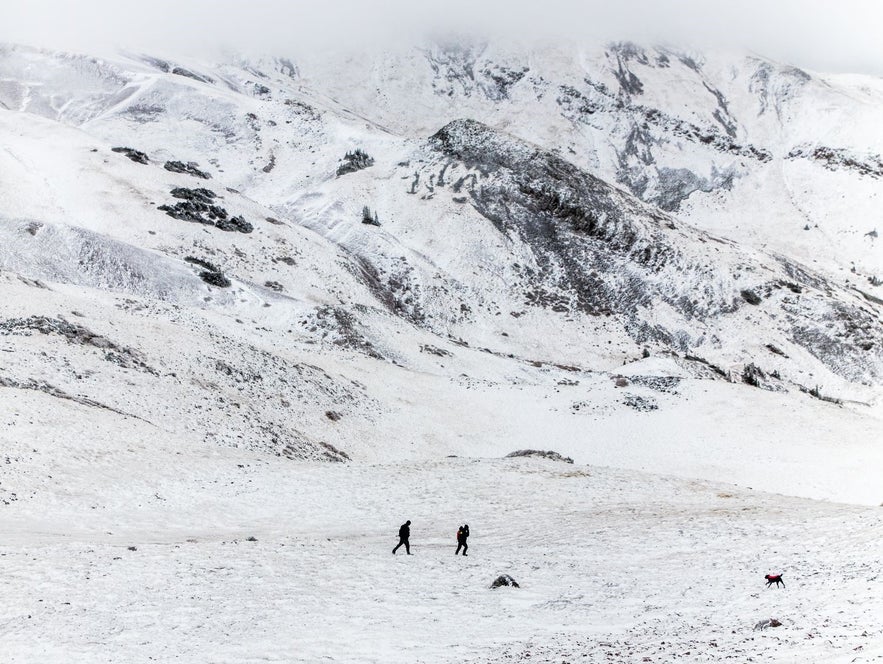 During winter in Iceland, safety concerns can arise. High winds can make driving hazardous and potentially cause road closures. Icy roads demand extra caution and appropriate vehicles with winter tires. Black ice can form suddenly, increasing the risk of accidents.
During winter in Iceland, safety concerns can arise. High winds can make driving hazardous and potentially cause road closures. Icy roads demand extra caution and appropriate vehicles with winter tires. Black ice can form suddenly, increasing the risk of accidents.
When traveling in the countryside in Iceland, avalanches can pose a danger in mountainous regions if there is heavy snowfall. When venturing into these areas, make sure to check the avalanche forecast of the Weather Office and adhere to local warnings.
It is essential to monitor weather and road conditions, stay informed, and adjust travel plans accordingly to ensure a safe and enjoyable winter visit. In case of an emergency, the national emergency telephone number is 112.
The Icelandic Wind Warning System
The Icelandic Meteorological Office provides a weather warning system to keep residents and visitors informed about potentially dangerous wind conditions. The system categorizes wind intensity using a color-coded scale: yellow, orange, and red. These warnings help travelers and locals make informed decisions about their plans and movements during periods of high winds.
Yellow warnings signify moderate winds that may cause minor disruptions.
Orange warnings represent strong winds that can lead to travel difficulties and potential hazards.
Red warnings indicate severe winds that pose significant risks to safety and infrastructure.
During the height of winter, yellow and orange warnings are common, and there's a risk of red ones. Hence, it's crucial to monitor the weather office website for up-to-date wind alerts, as extreme winds can cause poor visibility, hinder travel, and even pose risks to personal safety.
What to Pack for Winter in Iceland

Embarking on a winter trip to Iceland requires thoughtful packing to ensure comfort and safety in the face of unpredictable weather conditions. Make sure to keep your itinerary in mind when choosing what to bring.
If you're only staying within the greater Reykjavik area, you can get away with wearing lighter clothing. Prioritize warm inner layers and bring a warm coat, hat, scarf, and gloves. Wear leggings and a long sleeve T-shirt, preferably made from thermal materials, underneath your regular clothing to make them warmer. If the weather isn't too cold, you can even get away with wearing jeans this way.
If you're planning on exploring Icelandic nature, and especially if you'll hunt for the northern lights, prioritize bringing proper warm clothing that can be layered. You might be outside in freezing temperatures for extended periods of time. Start with a moisture-wicking base layer, add an insulating middle layer like fleece or wool, and top with a waterproof and wind-resistant outer layer. Insulated, waterproof footwear with good traction is essential for walking on icy surfaces.
Along with good clothing, here are some more essential items to pack for a trip to Iceland that will help you make the most of your adventure.
-
Skin protection: The cold can be harsh on the skin, so make sure to bring lip balm, moisturizer, and good hand cream!
-
Extra equipment: Bring a portable charger to keep your phone, camera, and other devices charged in cold temperatures. If you're heading to the countryside, take a headlamp or flashlight for navigating during limited daylight hours.
-
Crampons: If you're planning on heading out to the Icelandic wilderness, make sure to bring crampons to attach to your shoes! It will make it much easier to walk over icy surfaces.
-
Thermos: Bring a thermos or insulated bottle for hot beverages for your travels around the country.
-
Travel adapter: Don't forget to bring a travel adapter for charging electronic devices in Iceland.
-
Swimwear: No matter what time of year your trip to Iceland is, make sure to bring swimwear to enjoy the many geothermally heated lagoons and pools.
Photographing Iceland in Winter
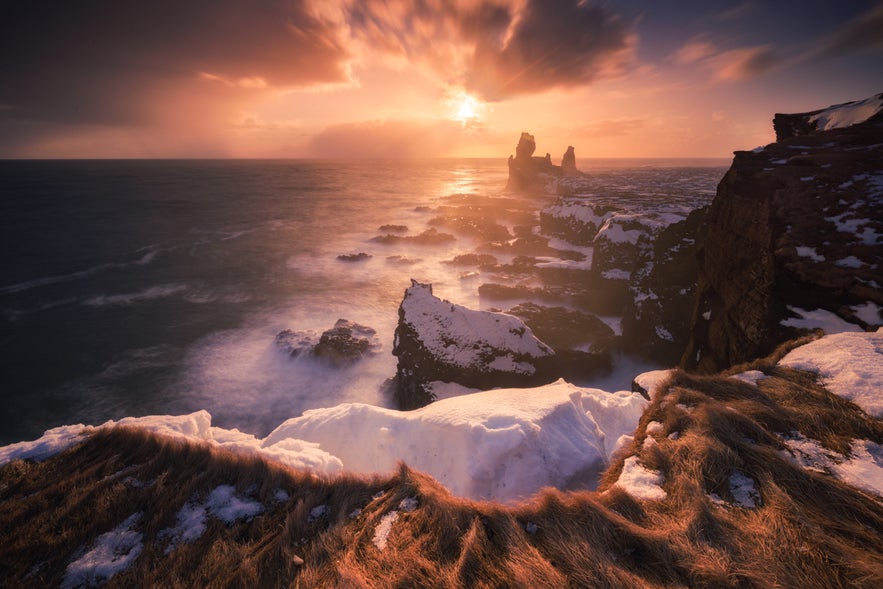 Photography in Iceland during winter offers unique opportunities and challenges. The low-lying winter sun casts a beautiful, soft light, ideal for capturing stunning landscapes. Attractions like frozen waterfalls, ice caves, snow-covered mountains, and of course, the northern lights provide spectacular subjects.
Photography in Iceland during winter offers unique opportunities and challenges. The low-lying winter sun casts a beautiful, soft light, ideal for capturing stunning landscapes. Attractions like frozen waterfalls, ice caves, snow-covered mountains, and of course, the northern lights provide spectacular subjects.
However, inclement weather conditions require planning and protection for your equipment. Use a sturdy tripod for long-exposure shots, especially for northern lights photography. Bring extra batteries, as they can deplete quickly in cold temperatures, and keep them warm when not in use. Lastly, lens hoods can be beneficial in preventing snowflakes from landing on your lens.
Wearing good gloves is also essential. Try to bring ones that have touchscreen capabilities so you don't have to take them off when interacting with the camera screen.
Driving in Iceland in Winter
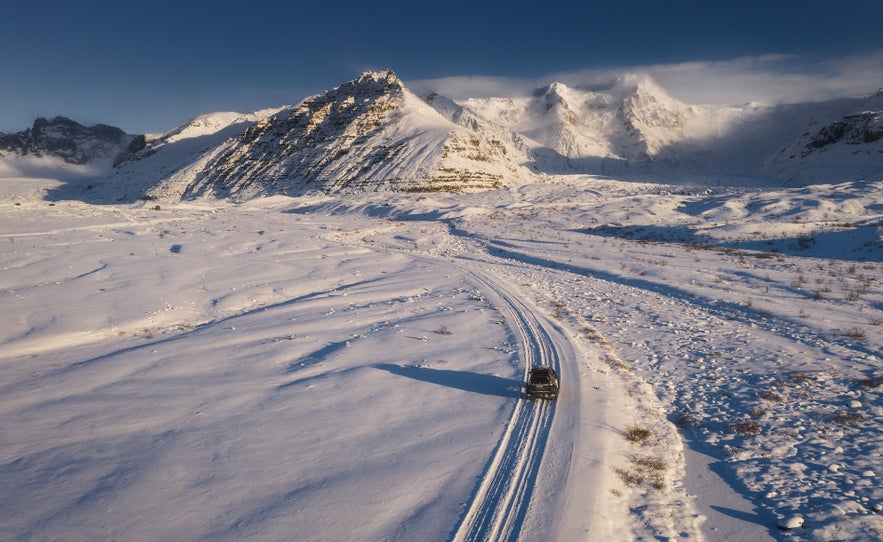 Driving in Iceland in winter can be a challenge. However, with proper planning, preparation, and caution, it is possible to navigate Iceland's winter landscapes safely and enjoyably.
Driving in Iceland in winter can be a challenge. However, with proper planning, preparation, and caution, it is possible to navigate Iceland's winter landscapes safely and enjoyably.
Renting a Car for a Winter Trip
If you're planning on taking a rental car, make sure to choose according to your itinerary and which month your trip to Iceland is. It's always safer to rent a 4x4 jeep in winter, especially if you're planning on exploring the countryside or arriving in January or February. In early winter, you can rent a small car though that can still cause a challenge if there's snowfall.
All cars in Iceland must be fitted with winter tires from November until the start of April. Additionally, make sure you have an ice scraper and snowbrush in the car. If there's a lot of snow during your trip, it could be a good idea to have a small shovel on hand in case you get stuck, especially if you're heading out to the countryside.
Driving Safely in the Icelandic Winter
 If you're planning to drive in Iceland in winter, make sure to take the time to prepare yourself. This is particularly important if you're not used to driving in challenging winter conditions. You can find tips for driving in Iceland on the Road and Coastal Administration website and check out the SafeTravel driving guide to prepare yourself.
If you're planning to drive in Iceland in winter, make sure to take the time to prepare yourself. This is particularly important if you're not used to driving in challenging winter conditions. You can find tips for driving in Iceland on the Road and Coastal Administration website and check out the SafeTravel driving guide to prepare yourself.
Check the weather and road conditions: Make sure to check weather forecasts and road conditions from reliable sources. In case of poor visibility due to high winds or snowstorms, pull over in a safe location and wait for conditions to improve. In case of an emergency, call 112 for help.
Reduce your speed: When driving in gravel, snow, or icy conditions, reduce your speed and maintain a safe distance from other vehicles. Use caution when approaching bridges, shaded areas, and blind curves, as these spots are more likely to have black ice.
Bring emergency supplies: Keep an ice scraper, snow brush, jumper cables, and a first-aid kit in your vehicle. If you're heading to a snow-heavy area, bring a shovel in case you get stuck. It's also a good idea to have water, snacks, and blankets with you for longer journeys.
Inform others of your plans: Inform someone about your travel plans and estimated arrival times, and always prioritize safety over adhering to a strict schedule. You can also submit a travel plan to the Icelandic Association for Search and Rescue. Ensure you have a fully charged phone or a GPS device for navigation, but it's also good to have a real map with you, just in case.
If you want to explore Icelandic nature but are worried about driving, consider letting others do the driving for you by taking a guided tour instead.
Winter in Different Parts of Iceland

Winter in the South of Iceland
During the height of winter, it's best to stick to the South of Iceland as the weather tends to be milder, and it's close to the capital city. Visitors can explore popular attractions like the Golden Circle, the Seljalandsfoss waterfall, and the Jokulsarlon Glacier Lagoon. Despite occasional road closures due to weather conditions, the South remains relatively accessible.
Winter in the North of Iceland
In North Iceland, winter is characterized by frigid temperatures, heavy snowfall, and icy roads. High winds and road closures can create challenges for travel. This area is still a popular destination during winter, as the largest town in the north, Akureyri, offers skiing and snowboarding in the popular Hlidarfjall Ski Resort along with optimal northern lights viewing conditions. If you want to explore the area but don't want to drive, you can take a direct flight to Akureyri from Reykjavik Airport or from different cities worldwide.
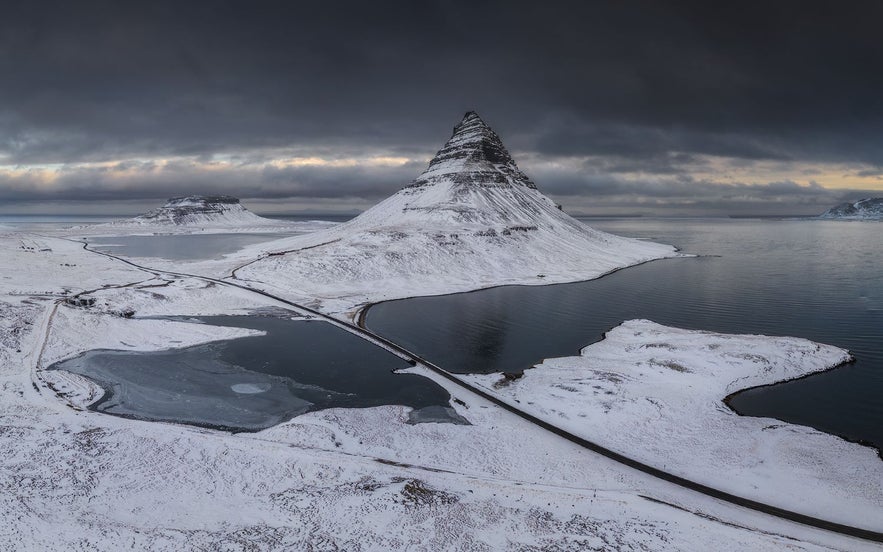
Winter in the West of Iceland
The West Coast of Iceland, including the Snaefellsnes peninsula, experiences cold temperatures, snowfall, and icy conditions. Accessibility to some attractions may be temporarily limited, but the region offers beautiful landscapes, such as the iconic Kirkjufell mountain.
Winter in the Westfjords of Iceland
The Westfjords of Iceland are not easily accessed during winter. This area sees heavy snowfall and extreme weather conditions during winter, and road closures and limited access to certain areas are common. It's much better and safer to explore the Westfjords during the warmer months.
Winter in the East of Iceland
The East of Iceland experiences colder temperatures and more snowfall compared to the South. Mountain passes can become challenging, and some roads may close temporarily, but if conditions are good, then it's a nice area for skiing, and you may even see some reindeer!
Despite the regional differences in winter weather, it is essential to be prepared for sudden changes in conditions across all of Iceland. Dressing appropriately and exercising caution while traveling are key to an enjoyable winter experience.
Icelandic Wildlife in Winter
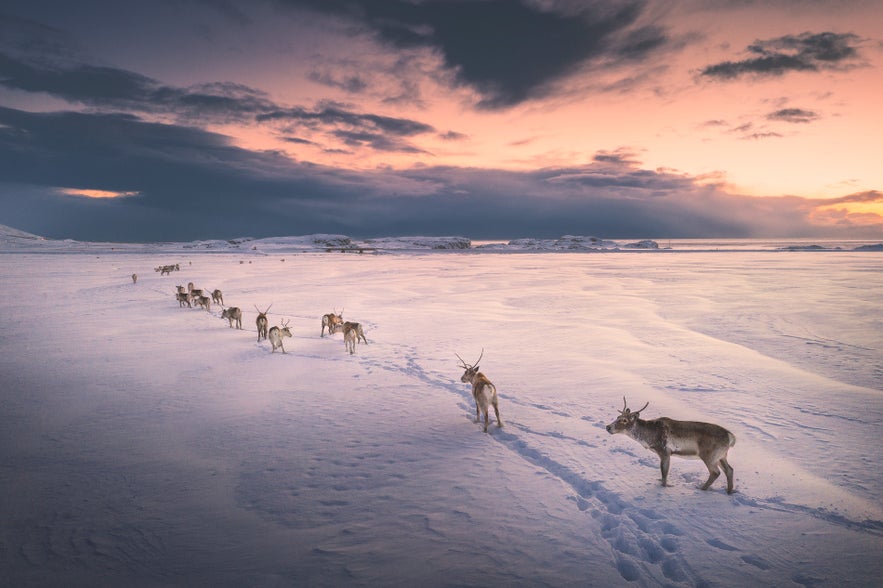 While some of Iceland's wildlife migrates or hibernates during winter, some animals have adapted to survive the winter conditions. These species showcase their resilience and unique characteristics during the colder months.
While some of Iceland's wildlife migrates or hibernates during winter, some animals have adapted to survive the winter conditions. These species showcase their resilience and unique characteristics during the colder months.
The Icelandic Horse: The most iconic Icelandic animal is the Icelandic horse, a hardy breed known for its unique gait and ability to withstand cold temperatures. They grow a thick winter coat to stay warm and can often be spotted grazing in snow-covered fields. Horse riding tours continue to operate during winter, allowing visitors to experience Iceland's landscapes on horseback.
Reindeer: Visitors may have the chance to spot reindeer when traveling around the East of Iceland. Introduced to Iceland in the 18th century, they thrive in the country's winter conditions, where they descend from the highlands to lower elevations, searching for food beneath the snow.
Arctic foxes: Iceland's only native terrestrial mammal, the arctic fox, adapts to the cold by growing a dense winter coat. It allows them to blend into the snowy landscape. Although challenging to spot, dedicated wildlife enthusiasts may have the opportunity to observe these elusive creatures.
Birdlife: Bird enthusiasts can spot native and migratory bird species during winter in Iceland, such as the ptarmigan, which changes its plumage to a white winter coat for camouflage. Guillemots can be observed along the coast, while the national bird of Iceland, the gyrfalcon, may be seen hunting.
Marine life: You may see white-beaked dolphins and harbor porpoises frequently off the coast of Iceland, and there's a chance of spotting minke whales and even humpbacks!
Winter Holidays And Events in Iceland
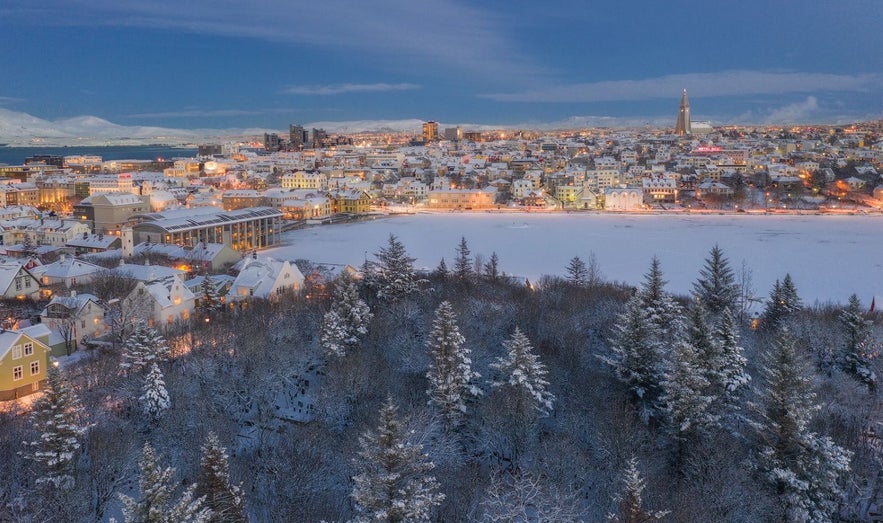
Winter in Iceland is a season of celebration, marked by a diverse array of holidays and events. Despite the cold temperatures and limited daylight hours, Icelanders embrace the season with warmth and revelry. Visiting Iceland in winter, therefore, offers a great opportunity to participate in the country's festivities!
Spending Christmas in Iceland
Like in many cultures, the highlight of the Icelandic winter season is Christmas, or "jól" as it's called in Iceland. There are many unique Christmas customs and food, which make for a memorable experience when visiting. You'll find many activities going on in Reykjavik and surrounding towns. Check out the skating rinks and Christmas markets, and keep an eye out for concerts and other events during this time!
Make sure to try the traditional Icelandic Christmas foods. Many restaurants offer special holiday menus, allowing visitors to partake in the country's culinary traditions. Don't miss out on the smoked lamb (hangikjot) and leaf bread (laufabraud) or the popular Christmas drink "Malt og Appelsín" which is a blend of non-alcoholic malt and orange soda (trust us, it's good!)

The most important day of Christmas in Iceland is December 24th, and you'll find that most businesses will be closed. There are some places that will be open a part of the day, usually only until 1 or 2 PM. On December 25th, most Icelanders are relaxing at home with family, so you're unlikely to find any open restaurants or shops on this day. More businesses will be open on the 26th, and most places should be back to regular opening times on the 27th of December.
Make sure to plan for these days well ahead of time with the assumption that businesses will be closed. We recommend taking this time to walk around Reykjavik and neighboring towns to explore the houses and parks or head out to the countryside if the weather allows. If you're in North Iceland during this time of year, make sure to visit the fairytale-like Akureyri Christmas House. Depending on your accommodation, it could also be fun to plan a cozy day inside with good food and relaxation!
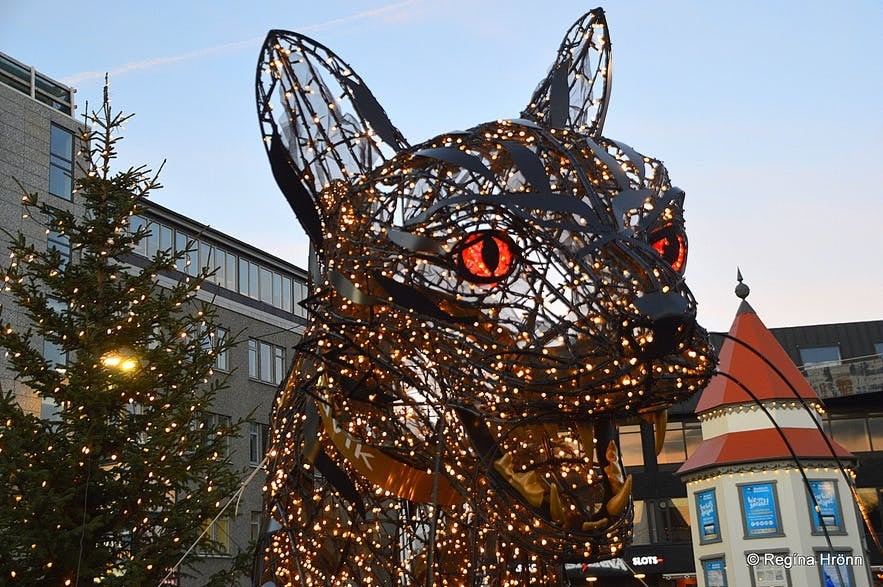
Photo by Regína Hrönn Ragnarsdóttir
Iceland has its own unique folklore related to Christmas. The holiday season begins with the arrival of the Yule Lads or Jolasveinar in Icelandic. They're 13 mischievous brothers who visit children each night leading up to Christmas, starting on the night before December 12th and ending on December 24th. The Yule Lads leave a small gift in the child's shoe, which is usually placed in their window.
The Yule Lads live in the mountains with their mother, Gryla, and her husband, Leppaludi. Gryla is a troll that comes to town every Christmas and steals away the children that have behaved badly. She also has a large black cat called the Christmas cat or Jolakotturinn, who likes to eat those who have not gotten any new clothing for Christmas!
You're likely to spot the Yule Lads, Gryla, and Leppaludi around Reykjavik as friendly visitors during many different Christmas events, sometimes even giving away candy to children. In December, you can also find a large menacing sculpture of the Christmas Cat in downtown Reykjavik (seen in the photo above).
The Icelandic New Years

Icelanders are known to go all out for New Year's Eve, so it's one of the best times to visit the country in winter. Unlike in many countries, people can buy their own fireworks during this specific time of year, which leads to a glorious fireworks show all over the city, as far as the eye can see! There are also many events going on, so you can really participate in the festivities.
On New Year's Eve, it's common for Icelanders to have a nice dinner with family or party with friends and go to a bonfire, or "brenna" in Icelandic. They can be found all over the capital area, and there may also be planned fireworks shows in the vicinity.
Another tradition is watching the yearly Aramotaskaupid, a satirical TV show that pokes fun at the year's events. It's possible to watch it with English subtitles on the country's main TV channel, RUV, though it may be hard to get the jokes unless you've been following the Icelandic news closely throughout the year.
The show is usually finished around 11:30 PM, and you're sure to notice it ending, even if you're not watching! As soon as it's finished, people rush outside to prepare their fireworks to make sure they're ready for midnight. This is the highlight of New Year's Eve, so be ready to head out by Hallgrimskirkja church, Perlan, the Kopavogskirkja church, or any other high-up location. The more you see of the sky above the city, the better!
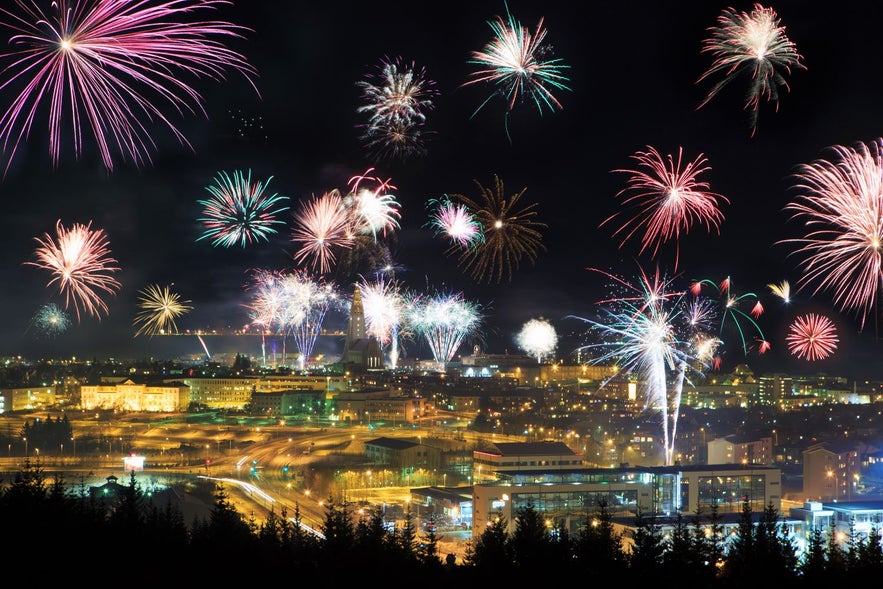 At midnight the sky lights up with fireworks all over the capital area, and you may hear churchbells ringing. Depending on your location, you can see fireworks going off in towns in the distance, like in Keflavik and Akranes. The show will go on for a few hours after midnight, so make sure to dress warm and bring your camera!
At midnight the sky lights up with fireworks all over the capital area, and you may hear churchbells ringing. Depending on your location, you can see fireworks going off in towns in the distance, like in Keflavik and Akranes. The show will go on for a few hours after midnight, so make sure to dress warm and bring your camera!
This can also lead to quite a bit of pollution hanging over the city, especially if there isn't much wind. Be mindful that this can cause irritation for those who have lung or heart conditions. If you'd rather not risk it or just prefer to be warm and cozy inside, we recommend looking for accommodation with a nice view to get a glimpse of the show! Here, you can find options for accommodation in Reykjavik when you're planning your trip.
New Year's Day in Iceland is typically a time for relaxation, hangovers, and spending time with loved ones after the night of celebration, so many businesses will be closed on this day.
Overall, spending New Year's in Iceland is a magical experience where you can burn away the old year and welcome the new one with a bang!
Bolludagur, Sprengidagur and Oskudagur

Photo from the bakery Braud & Co, showing different types of "bollur" available on Bolludagur.
Icelanders celebrate three special days in February, known as Bolludagur, Sprengidagur, and Oskudagur. They take place on Monday, Tuesday, and Ash Wednesday and were originally meant to signify the start of Lent.
On Bolludagur, or "Bun Day," Icelanders indulge in cream-filled pastry buns called "bollur" as a treat, and they are sold in the tens of thousands all over the country. The following day, Sprengidagur, or "Bursting Day," is observed by feasting on a hearty meal of salted meat and split pea soup, reflecting the notion of eating until "bursting." Finally, on Oskudagur, or "Ash Wednesday," you'll find the city and towns bursting with life as children dress up in costumes and sing in shops in exchange for candy. Schools close early on this day, usually around lunch, to let children make the most of the day.
Make sure to participate in the festivities if you're in Iceland during this time. The pastry buns are delicious and can be found in all bakeries, and they're very simple to bake if you'd like to try making them yourself. Try the salted meat and slip pea soup on Tuesday, and if you're traveling with children, consider letting them dress up on Wednesday and go singing for candy as well!
Valentine's Day, Bondadagur and Konudagur
 Valentine's Day is a relatively recent addition to the Icelandic cultural calendar. Some Icelanders have embraced this holiday, with couples exchanging gifts, enjoying romantic dinners, or spending quality time together. However, two traditional Icelandic holidays, Bondadagur and Konudagur, have long celebrated the importance of appreciating your partner and others in your life.
Valentine's Day is a relatively recent addition to the Icelandic cultural calendar. Some Icelanders have embraced this holiday, with couples exchanging gifts, enjoying romantic dinners, or spending quality time together. However, two traditional Icelandic holidays, Bondadagur and Konudagur, have long celebrated the importance of appreciating your partner and others in your life.
Bondadagur, or "Men's Day," occurs on the first day of the old Icelandic month of Thorri, typically falling in January. On this day, women pamper the men in their lives, offering gifts or gestures of appreciation. Konudagur, or "Women's Day," is observed on the first Sunday in February and used to signify the start of the old month of Goa. On this day, men honor the women in their lives with similar expressions of love and gratitude.
You can often find restaurants and other businesses offering special deals in celebration of all three days, so keep your eyes open if you're visiting around this time.
Thorri and traditional food
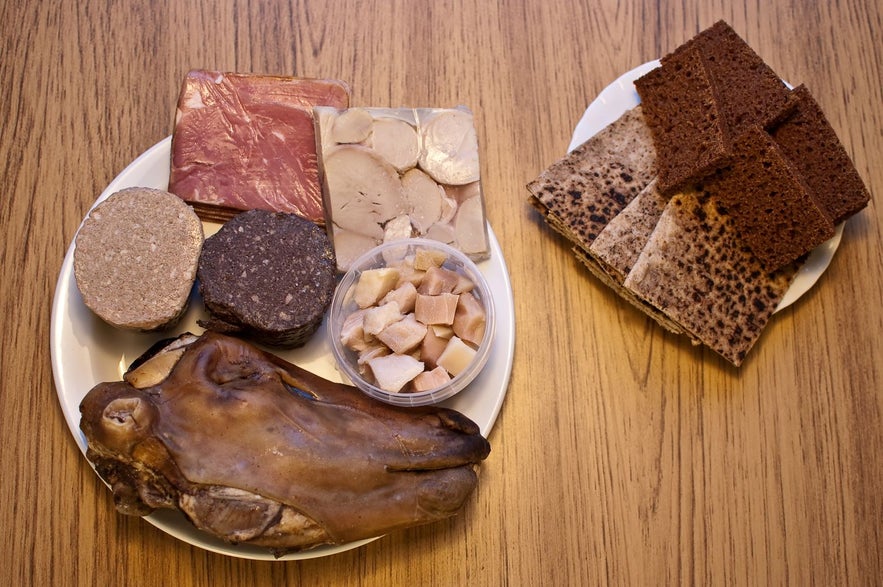
Photo from Wikimedia, Creative Commons, by The blanz. No edits made.
If you're curious to try the famous (or infamous) traditional Icelandic food, then visiting Iceland in winter is a good option. From January to February, you can participate in Thorri, an Icelandic mid-winter festival that celebrates the country's rich culinary heritage. During this period, many locals gather for "Thorrablot" feasts, indulging in traditional Icelandic foods, many of which have been preserved using historic methods.
The traditional menu typically includes hakarl (fermented shark), svid (singed sheep's head), hardfiskur (dried fish), and various prepared meats. The festivities are often accompanied by lively music, dancing, and drinking Brennivin, a traditional aquavit that is commonly known as "Black Death" in English.
Thorri provides an opportunity for Icelanders to embrace their cultural roots and appreciate the flavors and customs passed down through generations. Visiting during this time offers a great chance to get to know the nation's cultural history. If you want to immerse yourself in the Icelandic food culture, then you can choose from varied Icelandic food tours, where you can try both historic and modern cuisine.
FAQs About Iceland in Winter
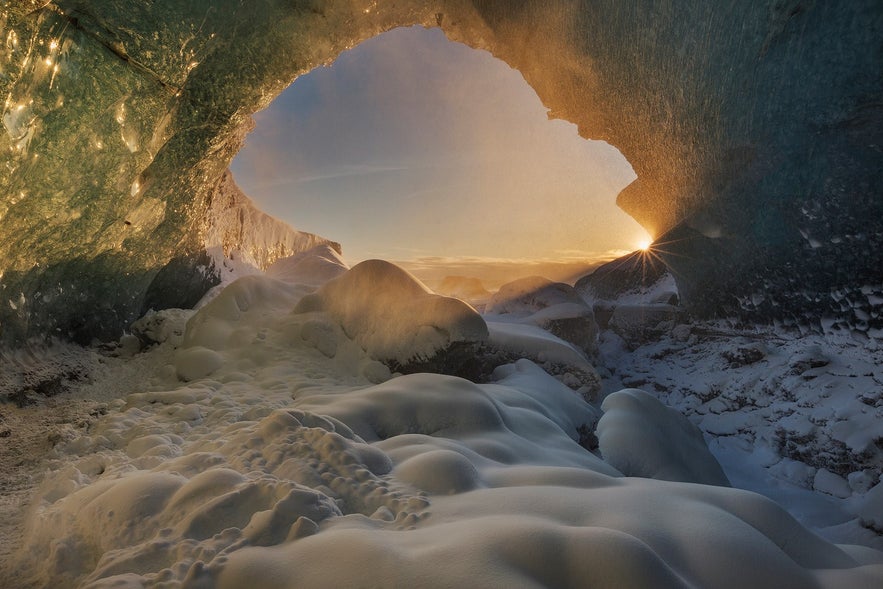
Here you'll find answers to the most frequently asked questions about Iceland in winter.
Are all attractions accessible in winter in Iceland?
Some attractions may be temporarily inaccessible due to harsh weather or closed for the season. However, many popular sites, like the Golden Circle, remain open. This especially applies to locations along the south coast of Iceland, as the weather there tends to be milder.
What's the best way to travel around Iceland in winter?
While driving is possible in winter, conditions can be challenging due to snow, ice, and high winds. If you're comfortable with winter driving, renting a 4x4 vehicle is recommended. Alternatively, many visitors opt for organized tours, which can handle transport logistics and ensure safety. Public transport may be limited, especially in rural areas.
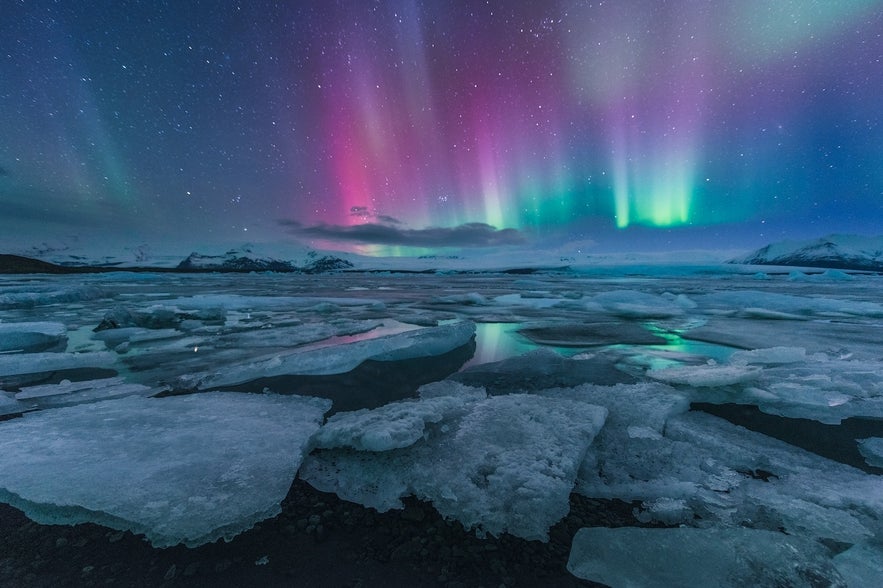
Is it safe to go glacier hiking or ice caving during winter in Iceland?
Yes, it's safe to go glacier hiking and ice caving in Iceland during winter, but only with a certified tour guide. These professionals understand the local conditions and ensure safety protocols are adhered to. They have the necessary skills, knowledge, and equipment to navigate these icy terrains safely. Always check weather conditions before you go, and never venture onto a glacier or into an ice cave alone or without proper guidance.
Can I camp during winter in Iceland?
Camping during winter in Iceland is possible, though it's not recommended during the harsher months. It requires careful planning, proper equipment, and consideration for safety. Most campsites close during the winter season due to weather conditions. It's best to rent a campervan or mini camper with heating, if possible. Otherwise, it's essential to have a sturdy winter tent, a warm sleeping bag, and appropriate camping gear designed for cold weather. Additionally, ensure you have a reliable heat source and know-how to handle winter camping challenges. Check out this article about Icelandic campsites in winter.
What can I do in Reykjavik in winter?
Reykjavik offers a range of activities in winter, from exploring the city's museums, art galleries, and geothermal pools, to experiencing its vibrant nightlife. You can also take a tour to see the northern lights or embark on a day trip to nearby attractions like the Golden Circle.
Summary of Iceland in Winter
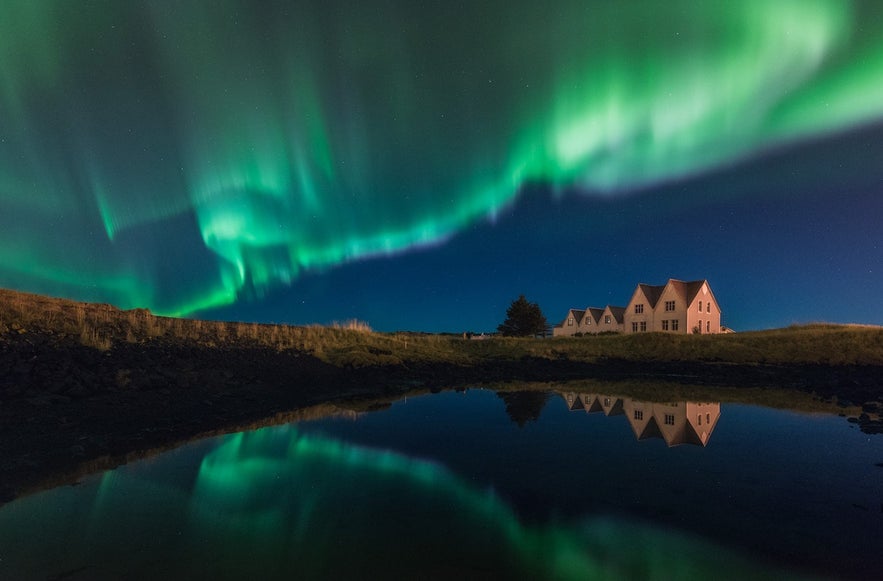 In conclusion, visiting Iceland in winter presents a unique opportunity to immerse yourself in a landscape that's both challenging and beautiful. Despite the cold temperatures and shorter daylight hours, the warmth of Icelandic hospitality shines through, whether in bustling Reykjavik or countryside villages. Winter celebrations, beautiful natural attractions, and thrilling outdoor activities make winter in Iceland an unforgettable experience.
In conclusion, visiting Iceland in winter presents a unique opportunity to immerse yourself in a landscape that's both challenging and beautiful. Despite the cold temperatures and shorter daylight hours, the warmth of Icelandic hospitality shines through, whether in bustling Reykjavik or countryside villages. Winter celebrations, beautiful natural attractions, and thrilling outdoor activities make winter in Iceland an unforgettable experience.
Remember to respect the unpredictable weather, keep safety a priority, and embrace the spirit of adventure that Iceland evokes. So bundle up, keep your plans flexible, and prepare for a journey to Iceland in winter!
Are you planning on a winter trip to Iceland? What experiences are you most excited about? If you have visited Iceland during the winter, tell us about it in the comments below.
Muita kiinnostavia artikkeleja

Islannin Kultainen kierros – täydellinen opas
Lue kaikki, mitä sinun pitää tietää, jos suunnitelmissasi on tehdä Islannin Kultainen kierros. Tutustu upeisiin luonnonnähtävyyksiin, kuten suihkuaviin geysireihin, jyliseviin vesiputouksiin ja kuul...Lue lisää
Islannin parhaat matkanjärjestäjät | Varaa huippuluokan opastettu retki
Löydä Islannin parhaat matkanjärjestäjät ja niiden mielenkiintoisimmat matkapaketit kiertoajeluista seikkailuelämyksiin. Lue artikkelimme, niin tiedät, mihin kannattaa kiinnittää huomiota matkanjärj...Lue lisää
Islannin Sininen laguuni – täydellinen opas
Opi kaikki, mitä sinun tarvitsee tietää Islannin Sinisestä laguunista. Tästä kattavasta oppaasta löydät tiedot siitä, mikä Sininen laguuni on, miten sinne pääsee, milloin se on avoinna, mikä on para...Lue lisää

Lataa puhelimeesi Islannin suurin matkailumarkkinapaikka, jotta voit hallita koko matkaasi yhdessä paikassa
Skannaa tämä QR-koodi puhelimesi kameralla ja paina näkyviin tulevaa linkkiä lisätäksesi Islannin suurimman matkailumarkkinapaikan taskuusi. Lisää puhelinnumerosi tai sähköpostiosoitteesi, niin saat tekstiviestin tai sähköpostin, jossa on latauslinkki.




















